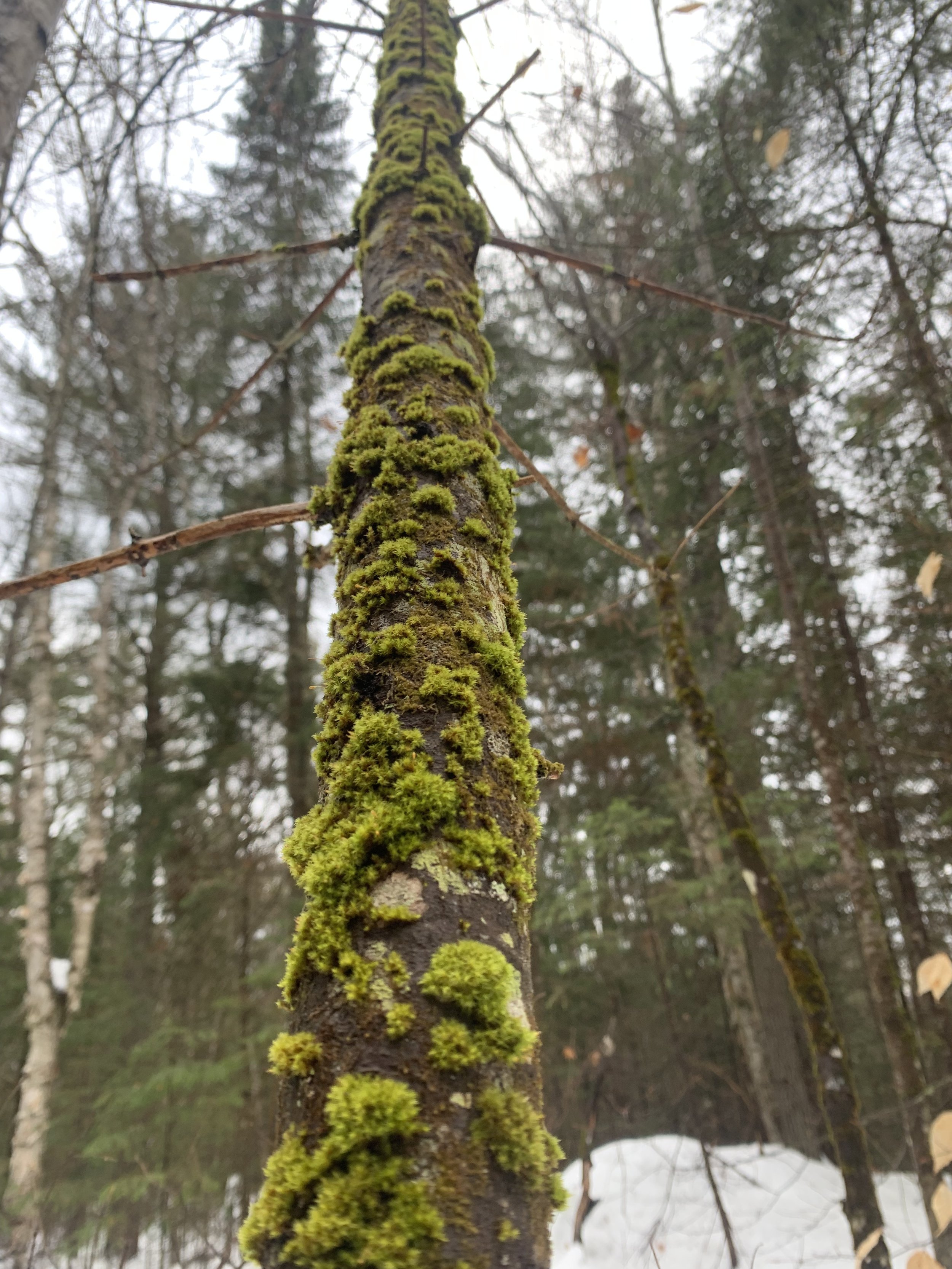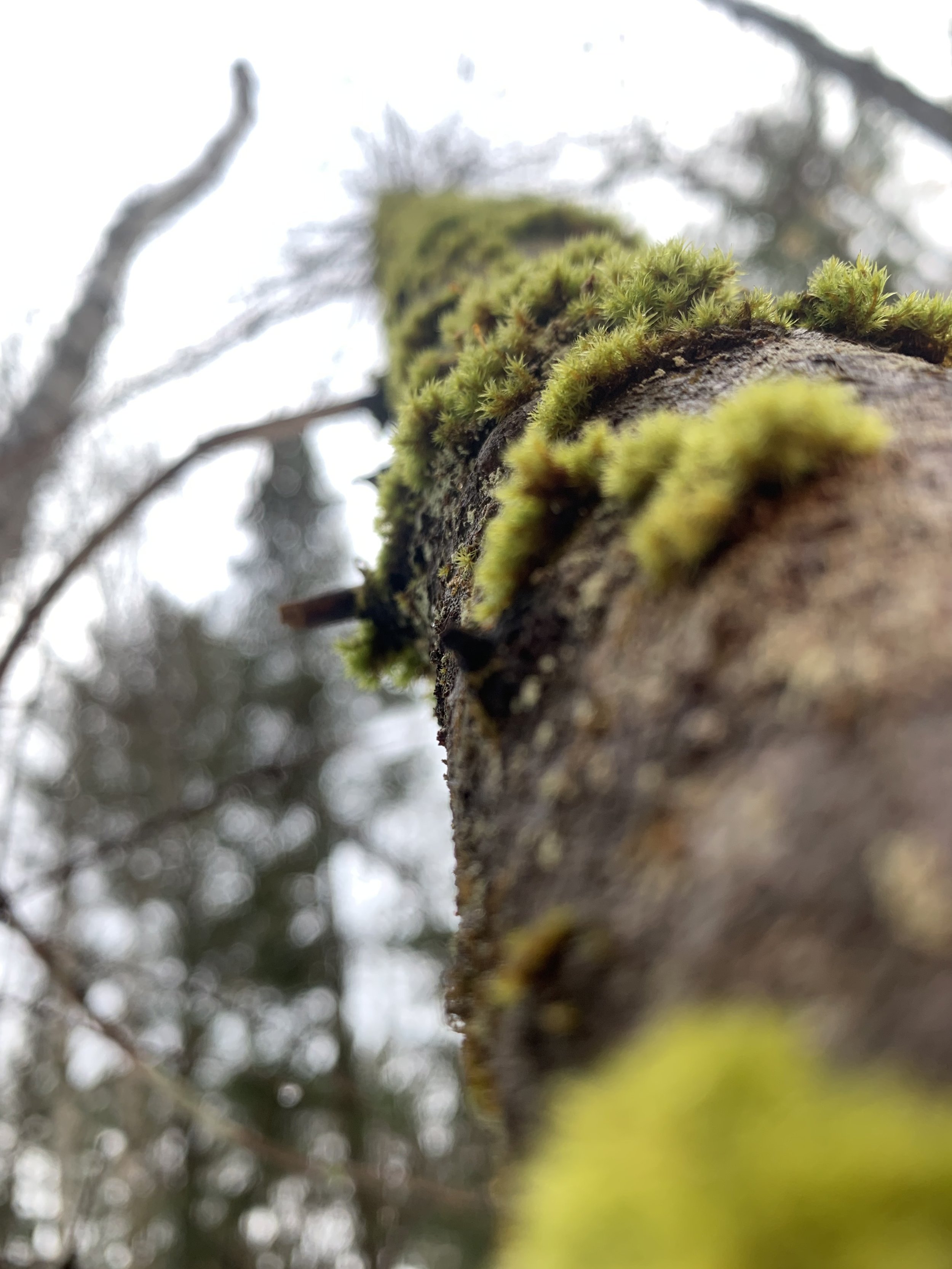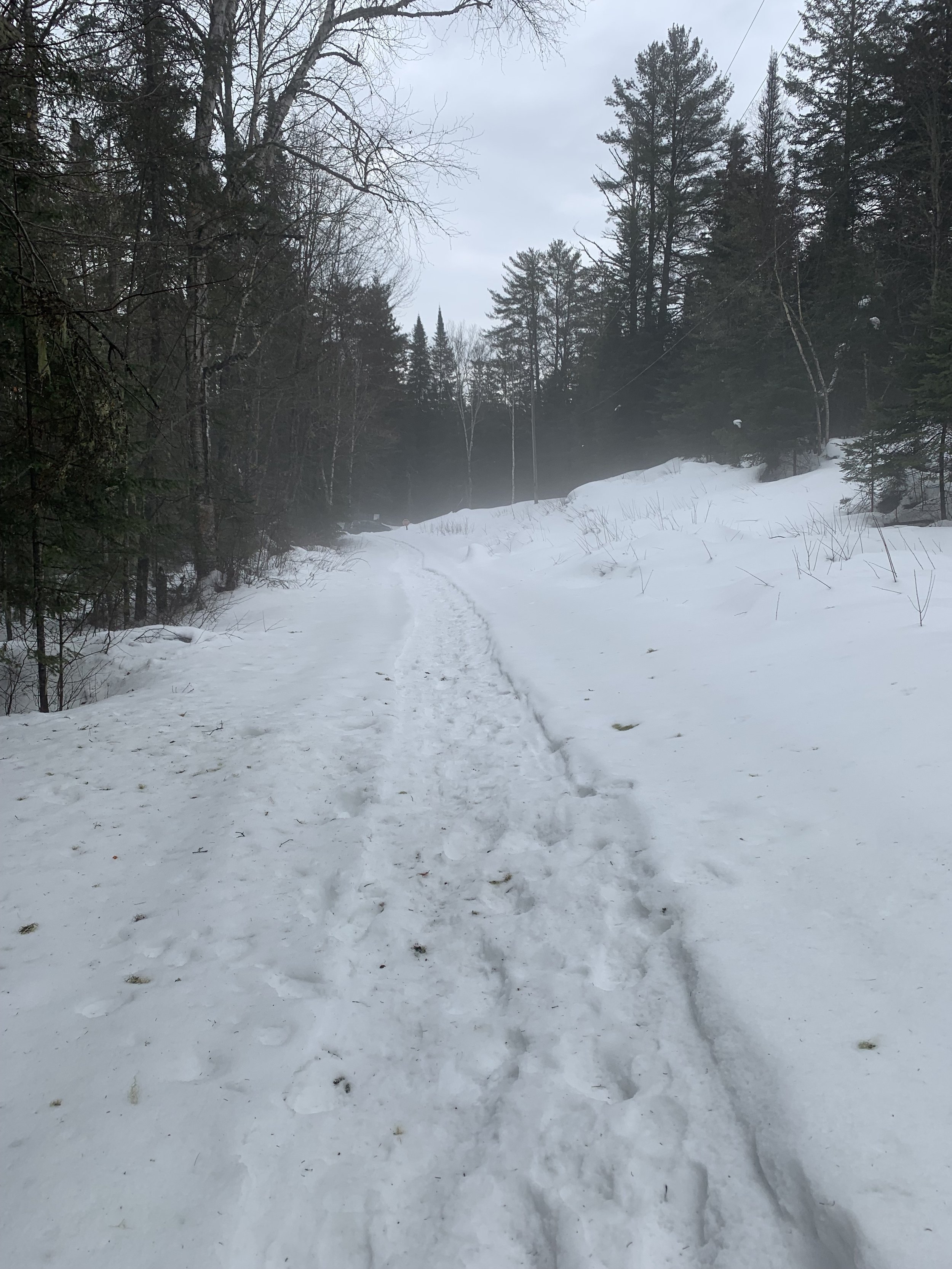Wednesday February 14, 2023
Day 3
Wednesday morning
Location: Wildlife Research Station cabin
Time: 8:28 am
What’s going on: Breakfast
Personal journal entry:
“A small room about 20 ft wide x 20 ft long, full of 2 couches, a comfy arm chair I currently sit upon, several hard framed chairs, 1 big long table, a fridge, and a tiny kitchen in the corner with 1 stove, a sink, and some cupboards. Right now holding 10 people, 15 when we are all in here. Folks are making breakfasts, and packing lunches for the day. Boiling water for hot tea in their thermoses, cooking bacon,I can small and hear it as I write. Some people look through animal ID books, Diana cuts out laminated tracking cards she just made with the laminator she brought. Some talk about tracking trips, outdoor schools, life in general, where the lid to the pot is, and how tired one may feel, as they ended up putting salt in their coffee instead of sugar. Everyone is stoked and preparing for the day. The day is Wednesday February 15. The ground outside is snow covered, the clouds are dropping a gentle sprinkle of rain, the temperature is mild, cold, but mild, like springtime. Its wet, damp, and beautiful! Its 8:45 am, we’ve got 15 minutes to get ready and prepared for the rainy wet day, and then we will head out, to hike up the road here to reach Chit Lake today, about 6km walk, snow shoeing through the forest.”.
The weather for today was to be a bit of rain, and warmer temperatures. We would hike to the Chit Lake cabin. What do you wear when you know its going to rain, when you know the weather will be a bit warmer, and that you’ll be snowshoeing essentially all day long to your destination and back?
I opted for rain gear. Rain pants, raincoat, and rainboots. I wanted to be waterproof. With a wool layer on my lower and upper body too, we walked up with snowshoes in hand to the dam up the road. We strapped in ups feet to our snowshoes, and began walking. Right away on our trail, we discovered tracks that were about 7.5” long, and about 5.5” wide, with a stride length of about 3ft or 36” long. If you have a measuring tape close by as you read this, I highly encourage you to go get it, and see what these measurements look like.
This was a big track. If you had never seen this type of track before, the most similar thing I could compare it to that I’ve seen before, and that perhaps most people may understand for scale, is a deer print or track. The only difference, is that this track is a lot bigger, to the point where you can literally put your whole hand into this track. Apparently Algonquin park does have White-tailed deer, however in the winter the tend to move on to different areas, as the snow levels get so high and deep in the park, its too hard of an environment for them to traverse with legs of that length. So who’s tracks could these belong to?
Unfortunately I did not take a photo of the tracks, as I was to enthralled with the fact that they were even there, and freshly made too. It was likely that this animal would have walked through here earlier that day, or perhaps the day before. I took measurements instead of photos, of what was moose tracks! No, not the ice cream! Real, hoofed, massive, moose tracks! This was especially exciting not only because the moose is from what I understand so far, the largest animal in the park, but also because of the first time I came out for this trip back in 2020. We had followed relatively fresh moose tracks from the roadside and down a big hill. Little did I know that moments later, after discovering scat, and a number of moose beds, I would mistake a real live moose for Byron. But when I urned around, Byron was behind me. So whatever I was seeing ahead of me in the forest, definitely was not Byron. I looked a bit longer and a bit harder, and it was a massive moose.
We had also come across a moose-kill that year too. For us to have come across moose tracks again, was special to me. Especially considering that down south in Guelph, where I live, we do not have moose.
The moose tracks were exciting, yet we stayed our corse and continued down the trail making our way into the forested rolling hills, to Chit Lake.
As we walked along, we noticed the moose tracks again and again. As though the moose would have crossed through the woods one way, and then circled back around to cross back, over and over and over. Like a good meandering wander! Based on its path of travel, I thought about how moose definitely do not deal with time-space. With these tracks, we could interpret and conclude that this moose was in fact feeding. When you looked close at the small trees close to the moose tracks, you could see that the tips of the young maple trees were gone, and left with a bit of a roughed or broken look to them.
From what I understand thus far about moose, and their teeth or jaws, is that they have only bottom incisors, at the front of their lower jaw, and no teeth above on the upper
front of the jaw. Therefore when they are feeding on something such as young growth on a tree, the bite mark will not be a clean, flush, smooth cut, as a cut may look, made by a pair of garden sheers. Instead it will be a bit rough, as the moose will bite down, the bottom incisors will do some cutting, but the upper front jaw being toothless at the front, results in more of a tearing or ripping action- indicative of the moose.
After much speculation and wonder, we carried forth!
Lobelia pulmonaria, or Lungwort Lichen, found growing on this Red Maple tree. Ive only ever seen this growing in the mountains of interior British Columbia. Makes me wonder about the similarities of the forests and air there, and in Algonquin park!
Oddly enough, I had found a small piece of this same lichen within a wolf scat from the previous day. Would a wolf eat this by accident, or on purpose?
The rest of this trek to Chit Lake, slowly, and gently, in an odd sort of sneaky way, became harder, and harder. For myself, I felt that snowshoeing in a bit of rain for 6 KM would be a wonderful and epic time. Yet, I was getting “schooled” as it were, by the elements, my body, and my choice of clothing.
Only an hour or 2 tops into the hike, I was feeling exhausted. Already? Me? Exhausted? Seriously? My world was getting shattered.
I thought I was in pretty good shape... I shared my exhaustion aloud to one of the main instructors on the trip, Lee. Lee responded with some wonderful insight and wisdom. She shared that often when she feels really warm or hot, she can confuse it with being tired, and that she has realized and become aware of this difference of feelings, differentiating the 2. I had an “A-ha!” moment. I was not actually exhausted, but hot. Overheating, and therefore feeling exhausted, due to my body not being able to properly breath. I was wearing rain boots, rain pants, and a rain coat. Not to mention my multiple layers on my torso and lower body, including one of wool on each. On top of that, I was hiking up and down beautiful rolling hills, wearing snowshoes, and carrying a backpack. Finally everything made sense. I had no option, but to layer down. I had taken off all of my rain gear. The thought of getting wet in any way from any bit or rain, or felling melted snow from the trees above, would not be an issue anymore, but graciously welcomed! Gentle, kind, cooling water droplets of relief. I had on leggings, woollen pants, and woollen socks. On my upper body, a wool tank top, and a thin button up long-sleeve. I could feel my body breath again! Wow, what an absolute relief, and game changer.
The feelings of exhaustion were banished, and my spirit lightened up. The crew came to a stop for a moment, and I heard my friend Danielle share that she was turning back, to go to the Visitors Centre. She had mentioned this plan of hers to me earlier that morning, in the event I may want to come with. I was experiencing a moment of indecision. Do I stay? Do I keep going? Moments later, our friend Diana shared that she too, would go back to do the same, and my decision was made, I too, would go back with Danielle and Diana! The idea of checking out the museum side of the Visitors Centre, felt comforting, and cozy, for a wet rainy day. Props to those who kept going, that was a real trek.
Diana and I planned to meet at 2:00 to go to the visitors centre. I made my way back to the Birdhouse cabin.
The next hour would compose of me simply just sitting, on the one big and comfy couch in the cabin, all alone, with 1 of the 2 electric space heaters pointed to my feet. Doing nothing but enjoying the solitude, the odd hum of the space heaters, and journaling about my day. They say to enjoy the simple pleasures in life, and I was definitely doing that. I set a timer for 30 minutes.
After holding my pen to my notebook and reviewing my day, I finished writing out my thoughts and finished with my journaling. With a sense of the soon coming sound of my alarm, and the need to get ready to go to the main cabin, my alarm went off. Its funny and really neat how we can sense time in our bodies, without even checking a clock. It took me about 10 minutes to get prepared to head out, and another 10 to walk back to the main cabin, in time before 2:00.
A small evergreen with many small patches of moss growing up the trunk.
This forest held a lot of moisture, based on how it felt, and the plant life, such as this moss growing happily in February.
A section of the trail that led from the Birdhouse cabin to the main road, that led to the main cabin. On this day it was particularly misty and eerie, in a wondrous, and calming way.
Diana showed up shortly after, and we were off to the visitors centre down the highway, to the East. The new few hours of the day would be Diana in the bookstore, and I exploring the history of the park in the small but thorough museum area, where I also found Danielle and Byron. After exploring the vast history of the park, I went to the bookstore to locate Diana, my ride back to the research station.
She was still there, so I took time to choose out 2 books to gift my son Lou, as well as a very soft plush toy of a wolf. One book was Animal Tracks Activity Book by Brett Ortler, illustratios by Shane Nietzsche, Anna Christenson, Julie Martinis and Bruce Wilson, and, me and you and the red canoe by Jean E. Pendziwol pictures by Phil. For myself, a small pocket sized book named Know your Clouds by Tim Harris, and Nols Wilderness Medicine 7th Edition by Tod Schimelpfenig. If you ever get the chance to be in Algonquin, I do recommend checking out the visitors centre!
The 4 books I purchased at the Algonquin Park Visitors Centre.
It was nearly 4:00 pm, the centre was about to close, but not without a final check on the Live Sightings board in the centre, that visitors are welcome to write in wild animals they see in the park, including time of day, and location. Towards the bottom, I noted a sighting that was from !0:45 am, the same day. The animal: Wild turkeys, 4 of them, location: the Visitors Centre! I instantly thought “I have to go find them!!”, as I hold a soft spot in my heart for this amazing bird. Yet I decided to let that go, as dinner time was on the horizon. Diana and I got in the car, and began to drive down the driveway back to highway 60. We turned the corner down the winding road, and then I let out a funny shreeky-scream! I think I startled Diana, but it was okay, because she knew why I made such a funny noise... It was the turkeys!
4 Wild Turkeys stood right there on the left side of the road atop the snowbank. Referencing my photos, I have a shot of them from 4:09 pm. Diana had the brilliant idea to out the car into neutral, so we would be a bit more soundless, but still able to watch, and roll by in some sort of “sneaky” way, past the turkeys like the true sneaky, 2 humans in a car we really are. At 4:11 pm, I took a video, where the 4 turkeys, one at a time, took off from the snowbank, one at a time. The first bird, jumped up, and flapping its wings flew across the road before us, to the right, and into the trees. The second, did the same, but flew upward a bit higher than the first, the third, doing the same, but flying ahead, and to the left, towards the trees and into the higher branches to land, and the fourth, kind of just jumped down onto the road, to the left, and proceeded to run on a diagonal in front of us, and up the road to the right, where it began to run faster, then straightening its self out, as though using the road like a turkey-runway, began flapping its wings, and took off up into the air, turning to the right, and landing half way up a big evergreen, close to where the other 2 turkeys had gone. I was ecstatic, my heart full of joy. Apparently wild turkeys haven’t always been in Algonquin Park, but there’s been 2 flocks more recently, one at ether end of the park. I felt so graced, to have witnessed these amazing birds, essentially, in my way, or on my path of travel, as though it was meant to be!
When we first approached the turkeys in the vehicle coming down the road.
Right before they started to take off into the trees.
Time: 6:05 pm
Location: Wildlife Research Station Cabin
Personal Journal Entry:
“Slowly folks roll into the small 20 ft x 20 ft room, (my own visual approximation, I did not measure this!) gathering for dinner.
It was a wet, damp, mild, icy day. Folks continue to sit on the couches and chairs, looking at books about birds, plants, mammals, tracking and more. Casual banter between people continues: topics of gear, birding, cardinals, how your day was, etc. Many smells fill this room. Lasagna in the oven, a pot of chai tea with turkey tail and chaga that I made, chilli, and other warm soups and stews like moose meat. The temperature in here is very warm. Perfect for a wet-icy day!”








